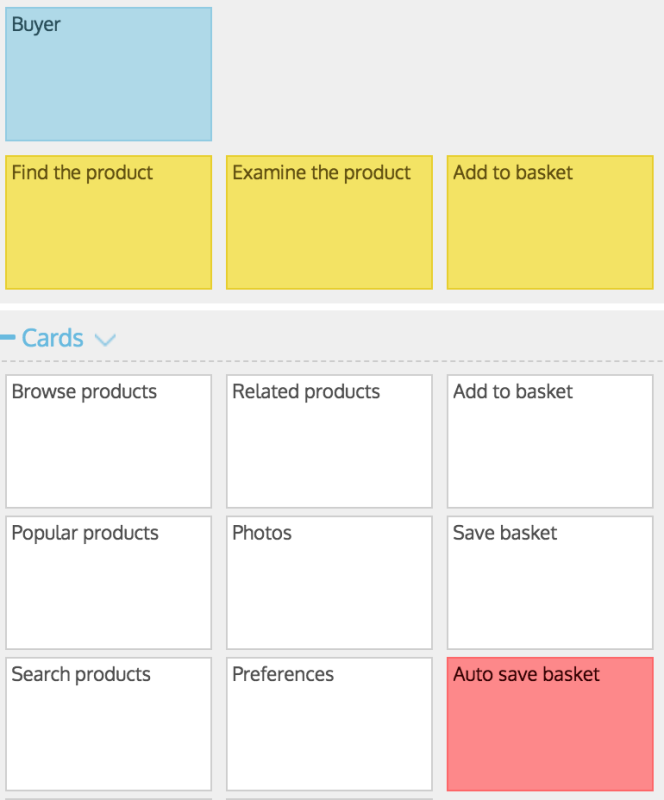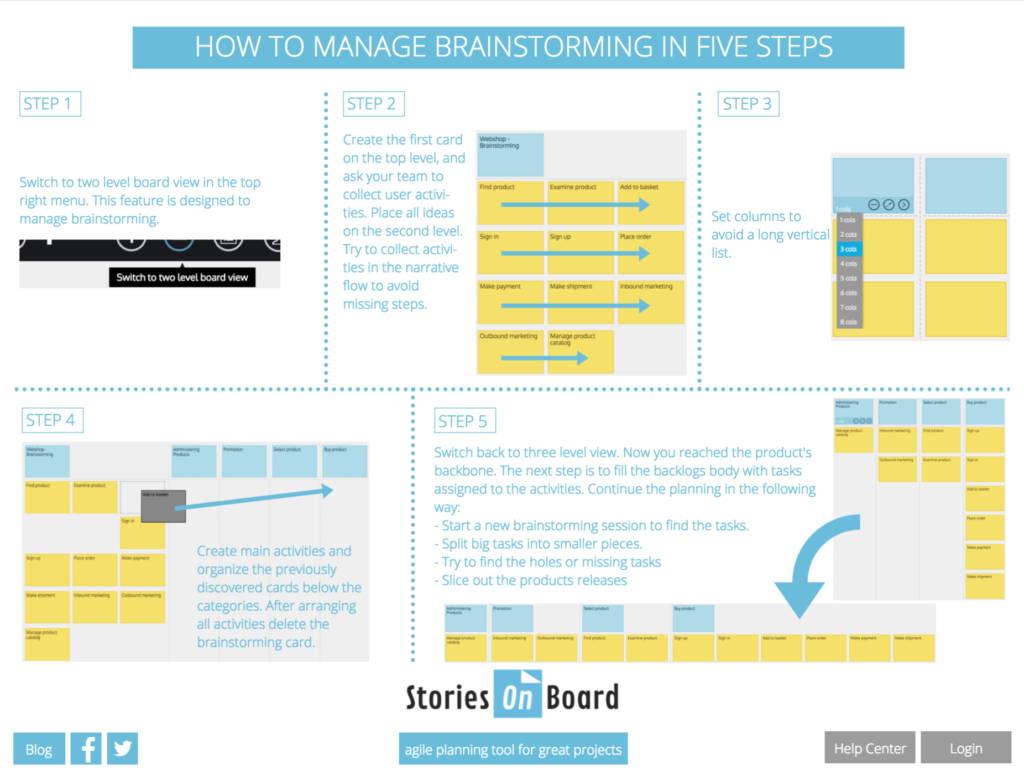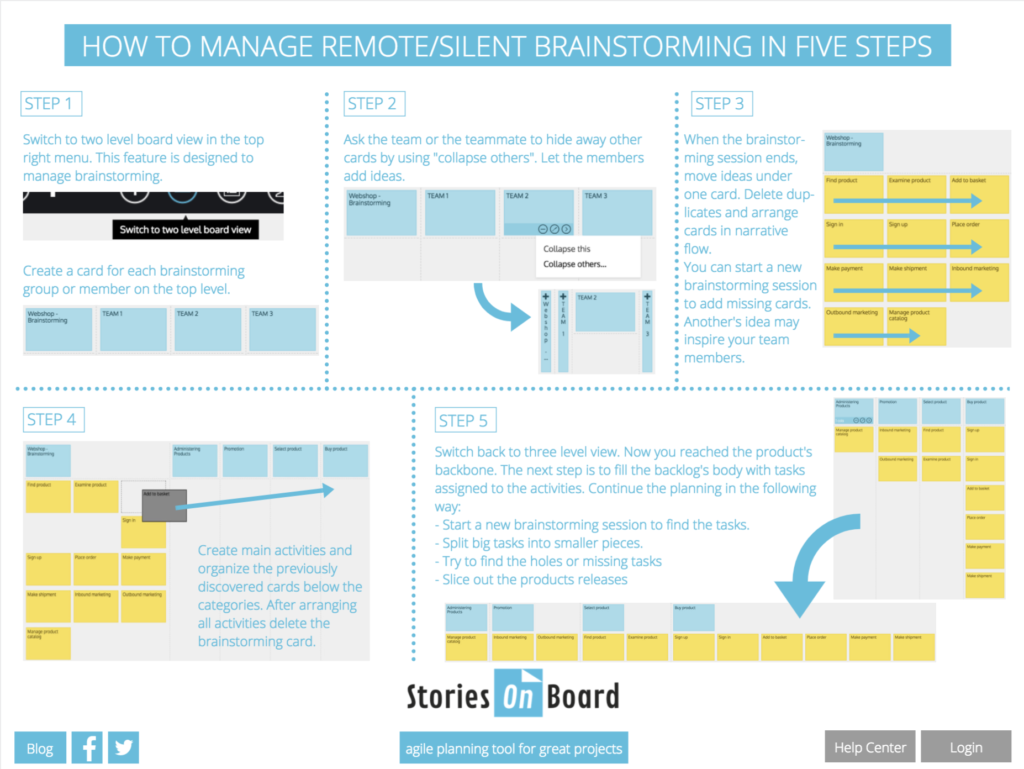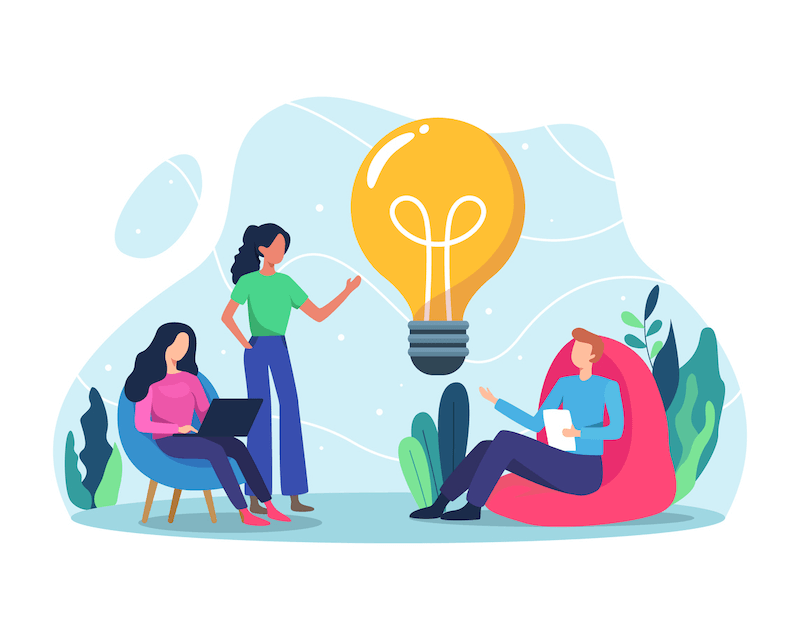A well-selected brainstorming improves agile planning. The efficiency of brainstorming depends on the following facts.
- Team’s knowledge about users and the production
- Skills of the facilitator
- Brainstorming techniques
Common brainstorming, silent brainstorming, and group brainstorming are the most popular brainstorming techniques. You can find many articles about these well-known brainstorming techniques on the web, but we would like to introduce five special methods for different situations.
Gap Filling In Brainstorming Technique
Concentrate on a selected part of a user’s journey or find a missing part between two steps or activities using the gap-filling brainstorming technique.
First, identify the current starting point, “A” and the goal point, “B” and then tell the steps between them.
Slice the journey into parts and declare the starting and the goal point of every part.
Let the team fill the gaps
Choosing a smaller scope lets you keep the pace of brainstorming and focus on what’s important.

Role Storming Brainstorming Technique
Role-storming is not far from the essence of user story mapping.
Telling a third person’s activity can cause difficulties during common brainstorming.
Break down these barriers by asking your participants to imagine themselves as a user.
Role storming is to tell a too-specific or a too-common user’s activity. Act out a scene with team members pretending to take the other’s point of view.
Reverse Brainstorming Technique
Sometimes we can’t describe exactly the benefit of the product which raises the question: Why should the user use the product?
Reverse brainstorming helps you answer the question. Find how the idea solves the customer’s problem or what the benefit of using the product is. Investigate users closely to find their pain points.

Instead of these
- “How does the idea solve the problem?”
- “How could we possibly cause the problem?”
- Ask these
“How could I possibly achieve the opposite effect? - “How do we achieve these results?”
If we know our users, we can solve their problems. Improve users’ satisfaction by finding how to make users more dissatisfied.
If you find what causes the biggest dissatisfaction, you’ll know which improvements make the users more satisfied. In software development, it means you remove features or services from the product and check the results.
Reverse brainstorming is the best way to check how big the user’s pain is when a feature is removed.
This method is strongly recommended for prioritizing and selecting the next implementable features. UX designers can benefit from using this method while creating a development plan.
Example: If a missing bank card payment causes the biggest pain, we should add new bank card payment possibilities.
Reverse brainstorming is a funny but creative part of brainstorming and motivates teammates to join the conversation.

Reverse Thinking Brainstorming Technique
This method is not equal to reverse brainstorming.
This method asks, “How would a typical user use the product?” Then imagine the opposite.
Would it work? Why or why not? Does the “usual” approach work well, or are there better options?
This method is useful when it’s not enough to explore a user’s behavior by using role-storming. It also helps small teams not to miss important information.
To explore all the possible activities, rethink every user’s choice from the opposite side. For example, different users can make different journeys on a website.
Example: Somebody leaves the webshop without saving the basket.
Brainwriting Brainstorming Technique
Brainwriting is a special type of silent brainstorming. Let each team member anonymously write ideas (users, activities, or tasks) on a card. The cards are randomly shared with other teammates who add content or criticize the ideas. Repeat the process until everyone has written on everyone else’s document. To reach a shared understanding, collect the cards and place them on the board. Brainwriting is useful when the project or the planning team is too big to speak about all the ideas.
AI‑Assisted Brainstorming
Pair strong facilitation with an AI co‑pilot to expand, stress‑test, and refine ideas fast. The AI can spin up variations, surface edge cases, and poke at assumptions so you move from raw thoughts to clear opportunities in minutes.
Seed the AI with real inputs: interview snippets, support tickets, reviews, and your desired outcome. During the session, ask for alternative user journeys, risks, counter‑ideas, and concise summaries. Capture the most useful outputs as cards, cluster them into themes, and turn the winners into testable hypotheses with clear signals of success.
- Suggest 10 extreme user contexts for [goal], plus one risky assumption for each.
- Rewrite this idea as a falsifiable hypothesis with acceptance criteria.
- List low‑cost experiments to validate or invalidate this concept within one week.
- Generate opposite‑approach solutions and explain when they outperform the usual flow.
Set guardrails: treat AI as a co‑creator, not the decider; avoid sensitive data; time‑box prompts; and validate outputs with quick user checks or experiments. That keeps brainstorming fast, creative, and evidence‑driven.
StoriesOnBoard in a two-level view can manage a brainwriting session easily.
How to manage a brainstorming session with StoriesOnBoard – 5 steps quick guides:


Brainstorming Techniques for Agile Planning: FAQ
When should I use gap filling?
Use gap filling when you need to sharpen a specific stretch of a user journey between point A and point B. Define the start and the goal for each slice, then map the missing steps. The smaller scope keeps momentum and aligns the team on what matters.
How do I run role‑storming?
Ask people to step into a real user’s shoes and act out the scenario. Speaking in the first person breaks the third‑person lens and surfaces concrete actions. It pairs well with user story mapping for structure.
What’s the difference between reverse brainstorming and reverse thinking?
Reverse brainstorming asks how to cause the problem—or create the opposite outcome—to expose pain points and hidden benefits. Reverse thinking imagines the typical use, then flips it to test whether alternatives work. Use the first for prioritization signals, the second to uncover overlooked behaviors.
Can reverse brainstorming improve prioritization?
Yes. Remove or negate features and watch where dissatisfaction spikes. Prioritize the work that most reduces that pain to guide your backlog.
When is brainwriting best?
Choose brainwriting for large or mixed‑experience groups where a few voices tend to dominate. Anonymous cards invite broad input and iterative builds. It’s efficient for tight time boxes or hybrid sessions.
How do we run these methods remotely?
Capture ideas on a shared board asynchronously, then discuss them live. Time‑box each slice, keep scope small, and attach comments or evidence for clarity. Close with a grouped view and clear next steps.
How does StoriesOnBoard help?
Two‑level views capture users and activities for gap filling and role‑storming. Cards support brainwriting rounds and quick grouping. Built‑in guides streamline on‑site and remote sessions, and outputs flow straight into story maps and backlogs.
How do we turn outcomes into an agile plan?
Translate activities into user stories with explicit start and goal points. Tag items by pain or opportunity from the reverse methods and prioritize what cuts the biggest dissatisfaction. Schedule the high‑impact items into near‑term iterations.
What pitfalls should we avoid?
Don’t take on too broad a scope at once. Don’t skip real user perspectives or let opinions dominate—use facilitation and anonymity. Always converge on a shared board to synthesize and decide.
Who should attend and how long should it take?
Include a facilitator, PO/PM, UX, an engineering lead, and people with deep user knowledge. Plan 45–90 minutes per technique with tight time boxes. For big topics, run multiple short rounds and document decisions right away.
